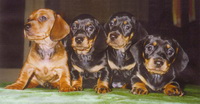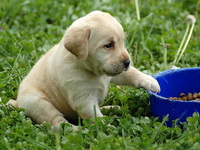Puppy testing
 The most complete information regarding the personal characteristics of puppies can be obtained as a result of special tests. Babies aged from 6 to 8 weeks can be objectively checked for fear of loud sounds, pain threshold, nervousness, dominance, the presence or absence of hunting and protective instincts.
The most complete information regarding the personal characteristics of puppies can be obtained as a result of special tests. Babies aged from 6 to 8 weeks can be objectively checked for fear of loud sounds, pain threshold, nervousness, dominance, the presence or absence of hunting and protective instincts.
For testing puppies, dog breeders recommend using the Campbell comprehensive test, which allows you to fairly accurately identify the peculiarities of the dog’s psyche, even at such a young age, and to give advice about the suitability of an animal for certain occupations. Tests are conducted in a quiet unfamiliar place so that nothing distracts the puppies’ attention. The person conducting the testing should strictly follow the prescribed actions, while carefully watching the kids, but stroking and talking with them is prohibited. The test consists of 5 points.
Campbell’s test
1. The test for sociability.
A person takes a puppy in his arms and puts it on the floor, after which he moves a few steps away from him. Then he squats down and claps his hands to attract the attention of the puppy. Further, the following types of behavioral reactions are possible:
A – the puppy runs up immediately with the tail raised up, jumps on the person, licks and bites the hands;
B – the puppy runs up immediately with the tail raised upwards, begins to scratch the person with its paws;
C – puppy runs up pretty quickly, but the tail is omitted;
D – the puppy runs up only after a while, and at the same time he feels insecure, is obviously confused;
E – puppy does not run up at all.
2. A test for the ability to follow a person.
Some time a person stands next to a puppy, and then begins, without turning around, to move away from him in the usual step. Further, the following types of behavioral reactions are possible:
A – a puppy with a raised tail immediately goes after the outgoing one, while it is cheerful and active, trying to grab the leg or shoes with its teeth;
B – a puppy with a raised tail immediately follows the person, gets underfoot or runs briskly alongside;
C – the puppy with the tail lowered runs after the man timidly, a little behind;
D – the puppy with the tail lowered very timidly follows the man, showing signs of confusion and fearfulness;
E – puppy refuses to follow the person, staying in place or going the other way.
3. The test of coercion.
The person turns the puppy on its back, belly up and holds it as long as possible in this position of obedience by the chest just below the throat. Further, the following types of behavioral reactions are possible:
And – the puppy actively protests, breaks out, fights with the hand, bites her and growls;
B – the puppy protests, but does not bite, but persistently turns out from under the arm;
C – the puppy protests at first, but then calms down and calms down;
D – the puppy does not protest, licks his hand, is set up peacefully;
E – the puppy is scared and lies motionless, or squeals, hysterically pulls out, trembles with fear.
4. The test of social superiority.
A person silently and calmly strokes a puppy standing or lying along the back. Further, the following types of behavioral reactions are possible:
A – the puppy behaves confidently, shows signs of domination himself, jumps on a person, puts his front paws on him, bites his hand, growls;
B – the puppy is active and cheerful, jumps on the person, grabs his hand with his teeth, bites and licks it;
C – the puppy turns to the man and licks the hand;
D – the puppy licks hands, turns over on its back, substituting a tummy for a person;
E – puppy squeals, presses to the floor and / or scaredly runs aside.
5. Test of dominance when taking a puppy in his arms.
The man raises the puppy above the floor for about 30 seconds, holding both hands under the chest and under the tummy. Further, the following types of behavioral reactions are possible:
And – the puppy actively protests, vigorously escapes from the hands, growls and bites;
B – puppy shows displeasure, but does not bite;
C – the puppy protests at first, but then calms down;
D – the puppy does not protest, quietly hangs in his hands, trying to lick a man;
E – puppy is scared, tense, presses ears.
In its pure form, the designations A, B, C, D, E mean the following types:
A – aggressive dominant;
B – prone to superiority;
C – obedient;
D – submitting;
E is sneaky.
After the test for each puppy count the number of all A, B, C, D, E.
The following options are possible.
• 2A and more in combination with several B. The dog is born a leader, has increased natural aggressiveness, stubbornness and rigidity. It is not recommended to take it to the family, especially with children. For the education of such a dog requires appropriate assertiveness and rigidity, which only an experienced trainer can do. The extreme variant (5A) says that in front of you is a protective and guard dog with a pronounced active defensive reaction. She is able to make decisions independently, acting viciously and hostilely towards a person.
• 3V and more. The dog has a tendency to superiority and leadership, but without undue aggression.



